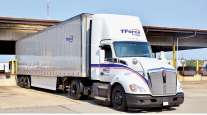Opinion: What Shippers Can Expect in 2019
The year 2018 was a record one for freight markets. Shippers weathered the challenges of constrained capacity and rising rates, and worked to transform their businesses to meet new customer demands and expectations.
So what does 2019 have in store? Here are some thoughts on the year ahead:
Steady Rate Hikes

Farrell
For 2018, industry analysts from FTR Transportation Intelligence reported 100% utilization of trucks, whereas utilization in 2019 is expected to dip toward 94% (similar to 2015).
While many economists are predicting somewhat softer economic performance in 2019, shippers should know that the purported easing is in part the aftereffect of an unusually strong 2018. Following a banner year, the year-over-year comps may appear weaker; however, they still reflect a growing underlying economy. As a result, many freight market analysts continue to predict strong freight demand and bullish markets driving steady rate increases through 2020.
LTL Shipping to Rise
Growth is likely to continue in this sector, but it will be different from that in the past. For example, as consumer and business demands change, expect LTL and specialty shipping to increase dramatically, driving changing needs for certain types of equipment and services. On the flip side, we see decreases in the average length of haul (from 800 miles to roughly 500 miles) as SKUs are more frequently positioned closer to the end user — both consumers and businesses.
Tariffs and Trade
The 90-day pause to a U.S. threat of escalated tariffs likely will increase freight volumes in the first quarter, particularly with the threat of a fresh round of tariffs on Chinese goods totaling 25%, which could take effect before March.
Intelligent Use of Capacity
With a continuing driver shortage, intelligent utilization of capacity continues to be a priority, and a competitive advantage to shippers and 3PLs that can get this right. As a result, sourcing capacity will become more data-driven and creative.
In this environment, shippers must push for route optimization through data, visibility and multimodal services.
Shipper of Choice
Carriers are increasingly evaluating freight opportunities from a “time to complete” rather than the traditional “rate per mile” perspective. Shippers with inefficient operations and long wait times that impact driver hours of service will need to evolve or risk decreased access to capacity and service levels. Shippers that can make their freight more attractive to carriers will enjoy more access to capacity, better rates and service improvements.
Predictive Analytics
While businesses have access to more data than ever, many also lack tools to use that data for real-time decision-making. Providing visibility is relatively easy; understanding what the data is telling you in real time and taking the appropriate action is much harder.
Shippers and providers will look more and more to artificial intelligence, machine learning and big data to provide the timely insights that drive cost savings and efficiency improvements while differentiating companies from their competitors.
Transformative Talent
As technology and data continue to shape our industry, the skill sets of the college graduates entering our workforce will be notably different than in the past.
While we believe our industry will always need truck drivers, we expect to continue to see talented young people who combine the skills of data-quantitative analysts with traditional business skills enter the logistics industry. After all, someone has to build the tools to make sense of all that data.
Autonomous Vehicles
Clearly, autonomous vehicles will play an important role in the future of our industry. In fact, the technology is already here.
What is lagging — and this is why I believe that human truck drivers are here to stay — is the infrastructure to support autonomous vehicles, especially in and around major metro areas. For example, if you’ve driven down I-95 on the East Coast of the United States, you know that it is ill-suited for autonomous vehicles. Instead, I expect consolidation centers to be constructed outside major cities, with autonomous vehicles handling the leg between them, with human drivers handling the final leg of the journey.
In the short term, I believe that platooning technology represents a greater potential impact to the industry.
Bob Farrell is executive chairman at GlobalTranz, a technology company providing award-winning cloud-based multimodal Transportation Management System (TMS) products to shippers, carriers, 3PLs and brokers.




